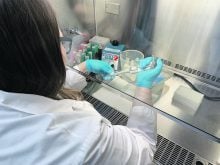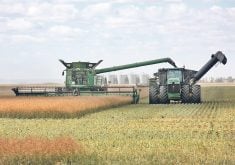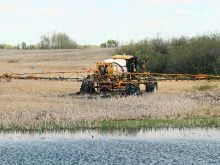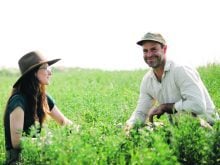Learning how seashore paspalum grows under stressful conditions may lead to crops that yield more with less fertilizer
If you enjoyed last year’s FIFA World Cup in Qatar, you likely watched the players doing some impressive skidding, sliding and sprinting on turf. That grass, commercially known as Platinum TE Paspalum, is the turf market’s most advanced variety of seashore paspalum, a grass species found on saltwater beaches and saline regions and native to tropical and subtropical America.
Seashore paspalum, also known as biscuit grass, saltwater couch and silt grass, is no slouch when it comes to stress resistance. It is durable, requires less fertilizer and pesticide inputs, recovers fast from injury, survives on less water and has exceptional tolerance to salt, heat and drought.
Read Also

Manitoba community projects get support from HyLife
HyLife Fun Days 2025 donated $35,000 each to recreation and housing projects in Killarney, Steinach and Neepawa earlier this fall.
Now, scientists at the University of Nebraska-Lincoln have researched the plant’s genome and gene expression to learn how seashore paspalum can grow so efficiently in such stressful conditions. The results offer opportunities to grow crops that yield more food with less fertilizer.
“The original reason we started working with paspalum was not related at all to stress tolerance but instead to photosynthesis,” said James Schnable at the university’s department of agronomy and horticulture.
“As part of a collaboration with the Joint Genome Institute (part of the U.S. Department of Energy) we were working to sequence its genome to understand more about how some grasses have evolved a unique form of photosynthesis that allows them to be more photosynthetically productive in hot and dry environments than most non-grass plants. Once we started growing paspalum, we noticed many of its other remarkable properties which led to the new line of research into its ability to grow more efficiently in nitrogen- and phosphorus-limited conditions.”
According to the team’s report, since the mid-20th century worldwide application of fertilizers has grown rapidly, and their costs are often the second largest input after seed application.
In the U.S. corn belt, five million tonnes of nitrogen and 1.8 million tonnes of phosphorus have been applied annually to corn fields since 2010 and, in the 2015 growing season, those fertilizers accounted for about US$5 billion in input costs. Then there are environmental costs including inefficient uptake or over-application leading to pollution of aquatic ecosystems and the threatened quality or safety of drinking water.
Reducing fertilizer use is an economic high priority and seashore paspalum may lead the way in that it does not require much nitrogen or phosphorus to thrive compared to its close relatives such as corn and sorghum as well as other grass crops.
That fact came to light serendipitously when a test pot of paspalum growing alongside other test plants was being monitored by Schnable’s team at the Nebraska Innovation Greenhouse.
“There was a period when no one remembered to water the paspalum plant for a couple of months,” said Schnable in a news release. “But the plant was completely fine. In fact, it usually grows so fast that it’ll try to invade the pots of neighbouring plants, and the greenhouse manager has to yell at me or folks in my lab to come down and trim it.”
That resilience led to experiments to grow the grass alongside corn and sorghum for several weeks under multiple conditions. When the two crops were denied nitrogen or phosphorus, their development was stunted. But paspalum continued steady growth.
To understand the grass’s tolerance in greater detail, the research team sequenced its genetic blueprint. When analyzing its genes and gene expression, they found that the grass responded to a lack of nutrients by doubling down on its production of a sugary molecule called trehalose, allowing continued growth.
While corn and sorghum produce some level of trehalose, they don’t respond to a lack of nutrients in the same way as paspalum. When the researchers applied trehalose directly to the crops it was equally ineffective.
Coming at the challenge another way, they looked at using an antibiotic to block the enzyme trehalase, which degrades and breaks down trehalose into glucose, to see if the reaction would lead to increased trehalose under nutrient stress and trigger increased growth.
The plan worked. Corn continued to grow, despite being nutrient deprived.
“We know that trehalose serves a number of different roles in corn plants, including some related to signalling and development,” said Schnable. “So, my guess is that part of the job of the natural enzyme is to remove trehalose that the plant has produced after it is no longer needed.”
He said that the team also suspected that the tolerance level relies on a process known as autophagy, a sort of recycling program.
“(Autophagy) functions as a natural recycling system within the cell, breaking down old proteins and other cellular components that are either damaged or no longer needed into their component parts that can be reused by the cell for other purposes.”
The researchers developed a mutant corn that lacked the ability to engage the last stage of the recycling process. As a result, despite a surplus of trehalose, the mutant failed to grow when deprived of nitrogen or phosphorus, confirming that autophagy was an important part of resilience.
“We’re not aware of other plants that have the same response of producing more trehalose in response to nutrient deprivation,” said Schnable. “But only a small fraction of all wild plants has ever been studied in any depth, let alone the types of metabolic profiling we conducted in paspalum. It might be unique to paspalum, or it could be quite common across many different wild plants adapted to stressful environments.”
He said that they still do not know what the genetic difference is that gives paspalum this unique response, causing it to produce trehalose when it lacks enough nutrients.
While genetic modification approaches may be an option in the future to take advantage of the qualities of paspalum, they are not there yet.
“This isn’t a path we’ve pursued yet,” he said. “Ideally, we’d like to find a naturally occurring genetic variation in corn that would let us replicate the pattern we see in paspalum without having to use genetic modification, given how slow and expensive it can be.”
Eventually he hopes that the target genes will become available to crop breeders looking to modify elite varieties of grass crops to provide both greater resilience and higher yield with less fertilizer.
The research was published in the journal Nature Communications.















